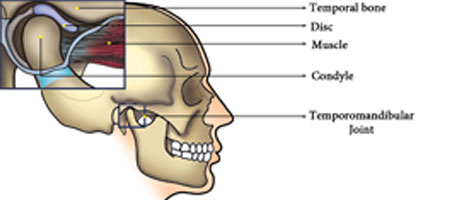- Introduction
- TMJ Growth Defects
- Locked Jaw

TM joints are located just in front of the ear and they connect the lower jaw to the skull.
The temporomandibular joint is a synovial joint i.e. joints that connect bones and allow movement. The bony components of the joint are the temporal bone and condyle (the round upper end of the lower jaw). The bony surfaces are covered by cartilage. The TM joint is lubricated and nourished by synovial fluid. The bony surfaces are separated by a disc made of cartilage called as meniscus. This disc acts as a cushion to absorb stress and allows smooth movement of the condyle while opening and closing the mouth.
TMJ disorders are a collection of conditions that are associated with pain or discomfort of the joint or its neighboring tissues, debilitating the movements of the lower jaw with or without clicking in the joint during function. This is rather commonly seen with adults and stress is reported to be a widespread precipitating factor.
Jaw joint disorders may be due to various causes like diseases e.g. arthritis, injury to the joint or habits like clenching or grinding teeth. Improper alignment of teeth or jaws may also lead to TMJ problems. Stress and emotional trauma may also be a major cause.
Symptoms:
TMJ disorders can be manifested by a number of problems including
- pain in the joint or in the jaw muscles, jaw pain, pain while chewing, biting, talking or yawning
- difficulty in opening or closing the mouth
- lock jaw
- clicking sound in the joint
- pain in the neck, dizziness, earache or headache
Treatment for some TMJ disorders:
Some problems in the jaw joint can be helped with simple treatments such as
- Medications to relieve pain or relax the muscles
- Resting the jaw joint by eating soft food and not using chewing gum, avoiding opening the mouth and yawning too widely.
- Correcting the bite, teeth and jaw alignment
- Relaxation and stress-reducing therapies
- Splints or ‘bite guards’ to cover the teeth at night to reduce clenching & grinding
- Physiotherapy treatments and gentle jaw exercises
- Treatment of any underlying causes such as arthritis
Intra-articular injection: Occasionally, a conservative treatment for a painful TM joint may include a joint injection called Intra-Articular injection. Commonly, a corticosteroid is injected into the affected joint to relieve symptoms of TMJ disorders. This treatment option is considered only in selected cases based on the severity of the disease and the patient’s general health conditions.
Some persons, by birth, may be affected by disorders of the TMJ. In some instances, the growth of the condyle i.e. the component of the lower jaw forming a part of the TMJ may be affected.
Micrognathia
A child’s lower jaw may sometimes be comparatively undersized than the upper jaw. This condition is termed as Micrognathia. The growth of muscles would also be simultaneously affected as the bony structure is smaller than normal. This condition could also be associated with various syndromes (Pierre-Robin’s Syndrome, Treacher Collin’s Syndrome etc). As the lower jaw is small, the tongue gets pushed backwards and tends to block the air passage. Distraction Osteogenesis is an effective treatment option to lengthen the jaw size. By this procedure the jaw can be brought to the normal size, without the necessity of bone grafting (bone harvested from hip bone to lengthen the jaw size).
Hemifacial Microsomia
In some individuals, there may be an imbalance between right and left sides of the face. This type of facial growth deformity characterized by facial asymmetry is called Hemifacial Microsomia.
In this condition, the structures of one side of the face grow lesser than the other side. This results in asymmetry of the face. The affected side of the face appears disproportionately smaller than the other.
Surgical correction
Choice of treatment to correct growth defects of the TMJ depends on many factors including age of the patient, severity of the defect and other associated deformities present, if any
Distraction Osteogenesis is the latest advanced and effective treatment option to lengthen the jaw length and correct facial asymmetry. By this procedure the jaw can be brought to the normal size, without the necessity of bone grafting (bone harvested from hip bone to lengthen the jaw size).
On the deficient side of the face, the jaw bone is cut and the distractor device is fixed. The two arms of the device are fixed to the two cut segments of bone. After a few days, a screw attached to the device is turned which pushes the two bone segments apart. New bone is formed in the resultant gap and the jaw bone gradually lengthens. After the desired volume of bone is formed, the distractor device is removed.
Another treatment is by using a bone graft from the patient’s own rib (Costochondral graft). This may be commonly done to restore severely affected mandibular condyles in growing children. The bone graft is fixed to the existing deficient portion of the mandible (lower jaw bone) using wires or screws.
The temporomandibulat Joint enables movements of the mandible (lower jaw) to aid functions like mastication and speech. Sometimes, one or both the joints may fuse. This is most commonly seen in cases where there has been prior trauma or injury to the joint. Due to fusion of the bones, jaw movement and mouth opening gets severely restricted and extremely painful. Surgery must be done to restore joint movement.
Gap arthroplasty along with bone graft from the rib (costochondral graft) may be performed in some cases to reconstruct the temporomandibular joint with ankylosis.
Unilateral ankylosis - Gap arthroplasty with costochondral graft


